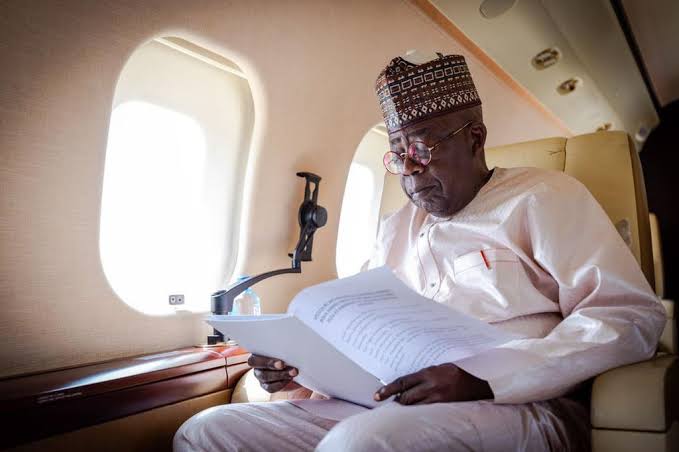National
Nigeria President-elect Tinubu travels out for lesser Hajj in Saudi Arabia

Nigeria President-elect Tinubu travels out for lesser Hajj in Saudi Arabia
The President-elect, Sen. Bola Tinubu, has travelled out for lesser Hajj in Saudi Arabia, as well to marshal out his transition programme, ahead of the May 29 inauguration.
Mr Tunde Rahman, his Media Aide said this in a statement on Wednesday in Abuja, adding that the President-elect left the Murtala Mohammed International Airport, Ikeja, Lagos enroute to Europe on Tuesday night.
“The President-elect decided to take a break after the hectic campaign and election season to rest in Paris and London.
RELATED STORY:Insecurity: Nigerian millionaire Engineer, Egbeoluwa, wife murdered in Lagos
“Preparatory to going to Saudi Arabia for Umrah (Lesser Hajj) and the Ramadan fasting that begins Thursday.
“While away, the President-elect will also use the opportunity to plan his transition programme,” Rahman said.
He cautioned media organisations against publishing rumours, fake news and unsubstantiated claims, urging them to always seek clarifications from the Tinubu’s media office before publishing.
Rahman said the President-elect had directed that all his senior aides and campaign staff to go for a short rest.
Nigeria President-elect Tinubu travels out for lesser Hajj in Saudi Arabia
EFCC
EFCC declares ex-Kogi Gov Yahaya Bello wanted

EFCC declares ex-Kogi Gov Yahaya Bello wanted
The Economic and Financial Crimes Commission (EFCC) has declared Yahaya Bello wanted for an alleged financial crime to the tune of ₦80.2 billion.
Nigeria’s anti-corruption agency called on those with vital information about the former Kogi governor’s whereabouts to reach the commission or the police.
According to the statement released on its official Facebook, the EFCC said, “Former Kogi State Governor, Yahaya Bello, is wanted by the EFCC for offences relating to economic and financial crimes to the tune of N80.2 Billion,” the EFCC said in a Thursday evening post on its Facebook page it captioned “Ex-Gov Yahaya Bello Wanted By the EFCC”.
Read Also: APC Petitions IG, Demands Arrest Of Nine Masterminds Over Ganduje’s Suspension
“Anybody with information as to his whereabouts should report immediately to the Commission or the nearest police Station.”
The report earlier gathered that the anti-graft agency warned that it may employ military intervention to locate and apprehend the former governor of Kogi State, Yahaya Bello, who has been evading capture.
Over the past weeks, the commission and the ex-governor have played a cat-and-mouse game.
Despite attempting to arrest Bello at his Abuja residence, the EFCC faced obstacles preventing his apprehension.
Reports suggest that the ex-governor might have sought refuge in the Kogi State Government House, taking advantage of Governor Ahmed Ododo’s immunity under Section 308 of the 1999 Constitution.
On Thursday, during the proceedings, the EFCC’s Counsel, Mr Kemi Pinheiro, stated to the court that the commission is committed to ensuring Bello faces trial, even if involving the military to apprehend him.
He said, “We may have to invite the military to move Yahaya Bello out of where he is hiding.
“We may have to engage the military to force him out because immunity does not cover him where he is hiding.
“No one is above the law. Immunity covers only the governor and not everyone around him.”
EFCC declares ex-Kogi Gov Yahaya Bello wanted
National
The Beauty of Abaya: A Timeless Fashion Statement

The Beauty of Abaya: A Timeless Fashion Statement
The abaya is more than just a garment; it is a reflection of tradition, culture, and personal style. For centuries, the abaya has been worn by women in the Middle East as a symbol of modesty and elegance. Its timeless beauty continues to captivate people around the world, transcending cultural boundaries and becoming a global fashion phenomenon.
Understanding the Abaya: More Than Just a Garment.
When we think of the abaya, we often see it as a black flowing cloak that covers the entire body, but its significance goes far beyond its appearance. The abaya holds deep historical and cultural roots that are worth exploring.
The abaya, a traditional garment worn by women in the Middle East, has a rich history that spans centuries. It is not merely a piece of clothing, but a symbol of modesty, tradition, and cultural identity.
The Historical Significance of the Abaya
The history of the abaya dates back to ancient times when women would wear loose, flowing garments to preserve their modesty and protect themselves from the harsh desert climate. In the scorching heat of the Arabian Peninsula, the abaya provided much-needed shade and protection from the sun’s rays.
Over the centuries, the abaya evolved into the elegant and sophisticated garment we know today. During the Ottoman Empire, the abaya became a symbol of noble status and wealth. Embroidered with exquisite patterns and crafted from luxurious fabrics, it was worn by women of high social standing.
As time went on, the abaya became more than just a practical garment. It became a reflection of cultural values and traditions. Different regions developed their own unique styles of abayas, incorporating local fabrics, colors, and embellishments.
The Abaya in Modern Culture
Fast forward to the present day, the abaya has become an integral part of modern Arabian culture. It is worn by women of all ages and backgrounds, serving as a means of self-expression and identity. Many designers have taken inspiration from the abaya, incorporating it into contemporary fashion collections.
With its ever-growing popularity, the abaya has now captured the attention of fashion enthusiasts and designers worldwide. Its influence can be seen not only in the Middle East but also in Western fashion. Fashion shows and exhibitions dedicated to abayas have emerged, showcasing the creativity and diversity of this traditional garment.
Furthermore, the abaya has become a symbol of empowerment for many women. It allows them to embrace their cultural heritage while navigating the modern world. Women have found ways to personalize their abayas, adding unique touches and accessories to make them their own.
Moreover, the abaya has become a medium for artistic expression. Talented artists and designers have transformed the abaya into a canvas, using intricate embroidery, hand-painted motifs, and innovative designs to create wearable works of art.
As the abaya continues to evolve, it remains a powerful symbol of cultural identity and tradition. It serves as a reminder of the rich history and heritage of the Middle East, connecting generations and bridging the gap between the past and the present.
The Abaya as a Fashion Statement
The abaya has undergone a remarkable transformation over the years. Today, it comes in various styles, colors, and embellishments, catering to individual preferences and fashion trends.
But what exactly is an abaya? The abaya is a loose-fitting, full-length robe worn by women in many parts of the world, particularly in the Middle East. Traditionally, it was predominantly black and designed to conceal the body, reflecting cultural and religious norms. However, as fashion evolves, so does the abaya.
The Evolution of Abaya Styles
Traditionally, the abaya was predominantly black and loose-fitting, designed to conceal the body. However, contemporary abayas have become more diverse, incorporating different cuts, fabrics, and designs.
Imagine walking into a store and being greeted by a dazzling array of abayas in vibrant colors like royal blue, emerald green, and deep purple. These modern abayas are not only visually striking but also allow women to express their individuality and personal style.
From tailored abayas with intricate detailing to modern interpretations with unique silhouettes, the range of styles available has made the abaya a versatile fashion staple for women around the world. Whether it’s a flowy abaya with delicate lace accents or a sleek, structured abaya with metallic embellishments, there is something for everyone.
The Role of Designers in Abaya Fashion
Designers have played a crucial role in transforming the abaya into a fashion statement. With their creativity and innovation, they have elevated the abaya from a practical garment to a wearable work of art.
Many renowned designers have embraced the challenge of reinventing the abaya while respecting its cultural significance. They experiment with different fabrics, textures, and embellishments, pushing the boundaries of traditional design.
Picture a runway show where models strut down the catwalk in abayas that are anything but ordinary. These designer abayas feature intricate embroidery, beading, and sequins, creating a dazzling display of craftsmanship. Some designers even incorporate traditional Middle Eastern motifs into their designs, paying homage to the abaya’s roots.
Moreover, the influence of designers has extended beyond the runway. In recent years, collaborations between high-end fashion brands and abaya designers have emerged, bringing a touch of luxury to the abaya market. These collaborations have resulted in limited-edition abayas crafted from luxurious fabrics like silk and adorned with exquisite handcrafted details.
Thanks to the vision and creativity of designers, the abaya has become more than just a piece of clothing. It has become a symbol of cultural pride, a celebration of diversity, and a testament to the power of fashion to transcend boundaries.
Beyond its aesthetic appeal, the abaya carries deep symbolism and meaning, serving as a powerful cultural icon and a symbol of modesty.
The abaya, a flowing and loose-fitting garment, holds a significant place in the hearts and minds of those who wear it. It is not merely a piece of clothing, but a statement of identity and values. It represents the essence of modesty, reminding individuals of the importance of self-respect and dignity.
In a world where fashion often emphasizes revealing and body-hugging clothing, the abaya stands as a symbol of modesty and a shield against the pressures of societal norms. It allows women to present themselves with grace and elegance while maintaining their values.
For many women, wearing the abaya is a personal choice that reflects their beliefs and values. It empowers them to embrace their cultural heritage and express their individuality. Each abaya is unique, reflecting the personality and style of the wearer. From intricate embroidery to delicate embellishments, the abaya becomes a canvas for self-expression.
The Abaya as a Symbol of Modesty
The abaya’s significance as a symbol of modesty extends beyond its physical appearance. It serves as a constant reminder to individuals to embody humility and simplicity in their actions and interactions. It encourages them to prioritize inner beauty and character over outward appearances.
When donning an abaya, women often experience a sense of empowerment and liberation. It allows them to move freely without the constraints of societal expectations. The abaya becomes a shield, protecting them from objectification and allowing them to focus on their accomplishments and contributions.
Moreover, the abaya fosters a sense of unity among women who wear it. It creates a bond that transcends borders and cultures, connecting individuals through shared values and experiences. It is a symbol of solidarity, reminding women of their collective strength and resilience.
The Abaya as a Cultural Icon
Throughout history, the abaya has become synonymous with Arabian culture and identity. It represents the rich traditions, customs, and values of the region. Its origins can be traced back to ancient times, where it was worn as a practical garment to protect individuals from the harsh desert environment.
As Arabian culture spread across the globe, so did the recognition and admiration for the abaya. Influential figures and celebrities have been seen wearing abayas, showcasing the beauty and diversity of Arabian fashion. This global recognition has not only elevated the status of the abaya but also increased appreciation for the cultural heritage it represents.
Furthermore, the abaya has become a source of inspiration for designers worldwide. Its elegant silhouette and intricate details have influenced fashion trends, leading to the fusion of traditional and contemporary styles. The abaya has transcended its cultural boundaries, becoming a symbol of fashion innovation and creativity.
In conclusion, the abaya holds a profound significance that goes beyond its physical appearance. It represents modesty, cultural heritage, and individuality. It serves as a reminder to embrace one’s values and express oneself authentically. The abaya is not just a garment; it is a symbol of empowerment, unity, and timeless beauty.
The Global Influence of the Abaya
The reach of the abaya extends beyond its origins, as it has made a significant impact on the global fashion scene.
The Abaya in Western Fashion
With the rise of cultural appreciation and inclusivity, the abaya has found its place in Western fashion. Designers and fashion houses have embraced the abaya, incorporating its elements into their collections.
Celebrities and public figures from various backgrounds have also embraced the abaya, wearing it on red carpets and other prominent events. This cross-cultural appreciation has brought the beauty of the abaya to new audiences.
The Impact of the Abaya on Global Fashion Trends
The abaya’s influence goes beyond being a fashion statement; it has had a significant impact on global fashion trends. Its flowing silhouette, attention to detail, and emphasis on elegance have inspired designers worldwide.
We see elements of the abaya in mainstream fashion, such as long, flowing dresses and loose-fitting outerwear. The abaya’s timeless appeal has proven that modesty can be fashionable and that cultural heritage can shape the future of fashion.
The Future of the Abaya in Fashion
The abaya continues to evolve and adapt to the changing fashion landscape. Designers and fashion enthusiasts are pushing the boundaries of traditional design, exploring new possibilities and innovations.
Innovations and Trends in Abaya Design
Technology and advancements in the fashion industry have paved the way for new innovations in abaya design. From 3D printing to smart fabrics, designers are incorporating cutting-edge techniques to create unique and modern abayas.
Moreover, sustainability has become a key focus in fashion, and this trend is reflected in abaya design as well. Designers are exploring eco-friendly materials and ethical manufacturing processes, ensuring that the abaya remains relevant in a changing world.
The Abaya in the Digital Age
As technology continues to shape the way we interact with fashion, the abaya has found a place in the digital world. Online platforms and social media have allowed designers to showcase their creations to a global audience.
The accessibility of online shopping has made it easier for women worldwide to embrace the beauty of the abaya. They can explore different styles, colors, and designs, finding the perfect abaya that reflects their personal style and cultural heritage.
In conclusion, the abaya is more than just a fashion statement; it represents tradition, culture, and personal expression. From its historical roots to its global appeal, the abaya has captivated people around the world with its timeless beauty. As it continues to evolve and adapt, the abaya will undoubtedly remain a symbol of elegance and empowerment for generations to come.
The Beauty of Abaya: A Timeless Fashion Statement
National
CBN Blacklist Fake Loan Apps, See Full List

CBN Blacklist Fake Loan Apps, See Full List
The Central Bank of Nigeria (CBN) has blacklisted several fake loan applications that have been exploiting unsuspecting Nigerians.
The Federal Government endorsed this move, declaring these apps illegal and a menace to society due to their deceptive operations.
These illegitimate loan apps have been causing significant distress through their harassment of users and victims.
Notably, these apps operate outside the legal framework, as they are unregistered with the federal government and have now faced an official ban.
Read Also: Naira Strengthens Against Dollar By 0.32%
The rise of fake loan apps is a pressing issue in the digital age, where the ease and appeal of online lending platforms have unfortunately also paved the way for fraudulent activities.
Scammers behind these apps lure individuals with the promise of straightforward loan approvals and quick money transfers, targeting those with poor credit scores or limited access to traditional financial services.
Victims, often in dire financial straits, are duped into submitting personal and financial information under the guise of securing a loan.
This sensitive data is then misused for identity theft, financial fraud, or other illegal activities, leaving individuals vulnerable and financially strained.
The CBN’s crackdown on these deceptive apps signals a commitment to safeguarding citizens from digital financial crimes and ensuring a secure environment for legitimate online financial transactions.
Here are the list of fake loan apps that have been blacklisted by the CBN:
EasyCredit
EasiMoni
KashKash
Speedy Choice
GoCash
Soko Loan App
Fast Money
GetCash
Icoin Loan
Naira Plus
9jaCash
LionCash
GMoney
Fast Money
9credit
Swiftkash App
Hen Credit Loan App
Cash Door App
Joy Cash-Loan App
Eaglecash App
Luckyloan Personal Loan App
Getloan App
Easeloan Apps
Naira Naija
Cashlawn App
Easynaira App
Crediting App
Yoyi App
Nut Loan App
Cashpal App
Nairaeasy Gist Loan App
Camelloan App
Nairaloan App
Moneytreefinance Made Easy App
Cashme App
Secucash App
Creditbox App
Cashmama App
Crimson Credit App
Galaxy Credit App
Ease Cash App
Xcredit
Imoney
Naira Naija
Imoneyplus-Instant
Nairanaija-Instant
Nownowmoney
Naija Cash
Eagle Cash
Firstnell App
Flypay
Spark Credit
Luckyloan Personal Loan App
CBN Blacklist Fake Loan Apps, See Full List
-

 Fashion7 years ago
Fashion7 years agoThese ’90s fashion trends are making a comeback in 2017
-

 Entertainment7 years ago
Entertainment7 years agoThe final 6 ‘Game of Thrones’ episodes might feel like a full season
-

 Fashion7 years ago
Fashion7 years agoAccording to Dior Couture, this taboo fashion accessory is back
-

 Entertainment7 years ago
Entertainment7 years agoThe old and New Edition cast comes together to perform
-

 Sports7 years ago
Sports7 years agoPhillies’ Aaron Altherr makes mind-boggling barehanded play
-

 Business7 years ago
Business7 years agoUber and Lyft are finally available in all of New York State
-

 Entertainment7 years ago
Entertainment7 years agoDisney’s live-action Aladdin finally finds its stars
-

 Sports7 years ago
Sports7 years agoSteph Curry finally got the contract he deserves from the Warriors





